The beluga whale belongs to the order Cetacea, the family Narwhals (Monodontidae). The scientific name of the beluga whale is Delpbinapterus leucas, which means “dolphin without a wing.” It is popularly called the white dolphin, polar dolphin, and also the singing whale.
Along with its closest relative, the narwhal, the beluga whale is one of the most social cetaceans. A huge concentration of snow-white animals in an Arctic bay is an unforgettable sight.
Origin of the species and description
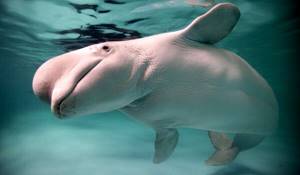
Photo: Belukha
The name Delphinapterus leucas comes from the Greek "delphis" - dolphin. "Apterus" literally translates to without a wing, which immediately indicates the beluga whale's lack of a noticeable dorsal fin. The species name "leucas" comes from the Greek "leucos" - white.
According to the phylum, Delphinapterus leucas belongs to the highest chordates. This oceanic mammal of the cetacean order belongs to the narwhal family. The only representative of the Belukha genus is (Delphinapterus de Lacépède, 1804).
Video: Belukha
The first descriptions of the beluga whale were created towards the end of the 18th century. Researcher Peter Pallas, while in Russia, heard about an unusual animal and recorded eyewitness accounts. Subsequently, during a visit to the Gulf of Ob, the naturalist was lucky enough to personally see and describe in detail a white whale in 1776. The animal was included and classified in animal reference books in 1804.
The beluga whale is considered a real find for biologists of all countries and is still considered an incompletely studied animal. Disputes about the unity of the white whale species arose in the mid-twentieth century. Some biologists tried to divide the toothed whale into species, while others insisted on uniform standardization.
Hypotheses about the origin of the species and debates about the structure of the animal’s genus raged until the beginning of the 21st century. Today, agreement has been reached on the issue of species membership. The white whale is defined by the one and only species of beluga whale.
Interesting fact: Scientists believe that the first whales descended from terrestrial mammals that returned to the water 55-60 million years ago. The first representatives of the narwhal family appeared later - 9-10 million years ago in the northeastern part of the Pacific Ocean.
Enemies
The beluga whale has only two enemies (sea and land) - the killer whale and the polar bear. These are the two most powerful and largest predators.
Polar bears really like the taste of beluga whales because of their thick layer of fat. In winter, bears set up ambushes near large thawed areas, and when a dolphin sticks its snout out to take a breath of air, the bear grabs it with its powerful paws. The bear pulls the stunned victim out of the water and eats it on land.
Killer whales also enjoy the meat of polar dolphins. Killer whales quickly and mercilessly attack dolphins in the water; it is almost impossible to escape from such a lightning-fast predator, since killer whales reach speeds almost twice as fast as polar dolphins.
If you find an error, please select a piece of text and press Ctrl+Enter.
Appearance and features
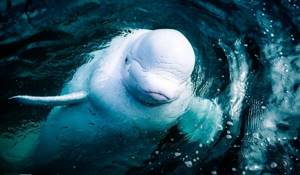
Photo: Beluga mammal
The beluga whale is called the ocean dolphin. A beautiful small head with a characteristic raised appendage, an elongated nose and a “smiling” mouth unmistakably identifies the whale as a relative of dolphins. The beluga whale's movable head distinguishes it from other relatives in the order. This feature was preserved in the species thanks to the vertebrae, which were not fused, like in other representatives of cetaceans.
Thanks to this feature, the toothed whale has outwardly pronounced shoulders, a wide chest and a body tapering towards the tail. The skin is smooth, glossy, elastic. The body length of an adult whale reaches 6 meters. The beluga whale has disproportionately small front fins compared to its body. Their length is 1% of the total body length - 60 cm, their width is 30 cm. Tiny flippers are compensated by the width of the tail. Its span is a meter, and sometimes more.
The anatomical and physiological characteristics of the whale are adapted to life in the Arctic. The weight of an adult male can vary from 1600 to 2000 kilograms. A large percentage of the weight is subcutaneous fat. In white whales it can reach half of their body weight, while in other whales it is only 20%.
Animals have well-developed hearing. The unique properties of echolocation allow the beluga whale to find breathing holes under the ice cover of the ocean. The white whale's graceful jaw contains 30 to 40 teeth. They have a wedge-shaped shape, which occurs due to the friction of teeth against each other. This is due to the whale's oblique bite. Slightly extended jaws and forward-sloping teeth allow the beluga whale to bite off its prey.
These whales are slow swimmers. The speed ranges from 3 to 9 km per hour. However, a beluga whale can reach a maximum speed of 22 km per hour and maintain it for 15 minutes. They have good maneuverability. They can move both forward and backward.
They enter shallow water when the water barely covers the body. Usually beluga whales do not dive very deep, about 20 meters. However, they are capable of diving to extreme depths. Under experimental conditions, a trained beluga whale easily made several dives of 400 meters. Another whale dived to 647 meters. A typical dive lasts less than 10 minutes, but they can stay underwater for more than 15 minutes.
Where does the beluga whale live?

Photo: Beluga whale
The toothed whale lives in northern waters:
- Ocean;
- Seas;
- Bays;
- Fjords.
It enters the shallow waters of the Arctic seas, continuously heated by sunlight. There are cases when beluga whales appear at river mouths. This happens in the summer. Whales feed, communicate and give birth. The water temperature at this time ranges from 8 to 10 degrees Celsius.
Beluga whales are found in the arctic and subarctic oceans of Canada, Greenland, Norway, Russia and Alaska. There are separate populations in the Gulf of St. Lawrence and the Sea of Okhotsk in eastern Russia. Throughout their range there are various populations that occupy distinct areas of the northern oceans.
Beluga whales live in the White and Kara seas. They often visit shallower coastal areas, but can dive several hundred meters in search of food. The toothed whale is found off the coast of Russia, Canada, Greenland and Alaska. Appears in the eastern part of Hudson Bay, Ungava Bay and the St. Lawrence River.
The beluga whale spends the winter months off the coast of Greenland, and with the onset of warmth, it swims to the western shores of the Davis Strait. There is evidence that whales have been seen off the coast of Scotland in the Edinburgh Strait. Until the middle of the last century, the beluga whale entered the large rivers Ob, Yenisei, Lena, and Amur, sometimes rising hundreds of miles upstream.
Beluga whales are most common in the coastal waters of the Arctic Ocean, but are also found in subarctic waters. Whales migrate south in large pods when the water begins to freeze.
Reproduction
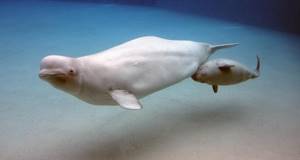
Puberty in beluga whales occurs late: in females at the age of 4-5 years, and in males no earlier than 7-9 years. Before mating, which occurs in April-June, males conduct spectacular but peaceful tournament fights, during which they do not harm each other. The winner retires with the female to a secluded place to mate.
Pregnancy lasts more than a year - approximately 14 months. Before giving birth, the female swims to river mouths, where the water is warmer. As a rule, only one cub up to one and a half meters long is born; twins are an extremely rare occurrence. The beluga whale is a mammal, that is, the female feeds her baby with milk. Feeding lasts up to two years, often at this time the beluga whale is already pregnant again. The ability to bear children is lost at the age of 20.
The kids stay close to their mothers until puberty, that is, they leave their native flock at the age of 4-6 years, after which the young animals gather in a new group.
What does a beluga whale eat?
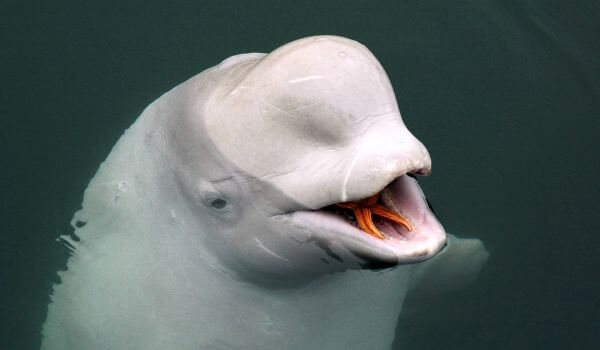
Photo: Beluga animal
Beluga whales eat a fairly varied diet. They prey on approximately 100 species, mostly living on the seabed. The beluga whale's diet consists entirely of sea food.
Remains of crustaceans and invertebrates are found in the stomachs of beluga whales:
- Octopuses;
- Cuttlefish;
- Crabs;
- Shellfish;
- Sand worms.
The toothed whale has its own preferences in fish.
The diet includes:
- Capelin;
- Cod;
- Herring;
- Smelt;
- Flounder.
According to data obtained from keeping beluga whales in captivity, they eat from 18 to 27 kilograms of food per day. This is 2.5-3% of their total body weight.
Beluga whales usually hunt in shallow water. Its flexible neck allows it to perform complex maneuvers while hunting. Observations show that the beluga whale can take water into its mouth and push it out under strong pressure, just like walruses do. A powerful jet washes out the bottom. The suspension in sand and food rises up. In this way the whale can raise its prey from the day of the sea.
Beluga whale hunts schools of fish. Having gathered in a group of 5 whales or more, beluga whales drive schools of fish into shallow water and then attack. The whale is unable to chew food. He swallows her whole. Teeth are designed to securely hold or tear prey when hunting.
Zoologists also found wood chips, sand, stones and paper in the stomachs of beluga whales. In all likelihood, these elements enter the body of whales during hunting in shallow waters. Whales cannot swallow food whole. Their swallowing apparatus is not suitable for this and they may simply choke. Therefore, beluga whales catch small fish, or pinch off and tear them.
Reasons for the disappearance of the beluga
- Poaching and illegal collection of caviar.
- Ecological deterioration.
- Irrational use of resources.
All this led to a reduction in the number of this species; it began to lay eggs rarely and became small in size.
Currently, this type of fish is listed in the Red Book. Special services are fighting poachers. In many cities and countries around the world, it is bred artificially to maintain the numbers of endangered fish. Thanks to all this, there is hope that these fish will become numerous and large again. And if not us, then our children or grandchildren will be able to see the giants with their own eyes.
Features of character and lifestyle
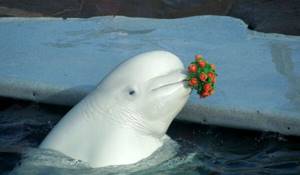
Photo: Belukha
Beluga whales are herd animals. They gather in groups of several hundred individuals. There are cases when a colony of beluga whales reached more than a thousand mammals. Beluga whales need air. Whales spend about 10% of their time on the surface.
The whale has well-developed communication abilities. Beluga whales communicate in high frequencies and use echolocation. The sounds produced are harsh and loud. They resemble the calls of birds. For this reason, beluga whales were nicknamed “sea canaries.” Their voices sound like chirps, whistles and screams. The toothed whale is considered one of the loudest in its biological order. It uses vocals during play, mating and communication.
Beluga whales also use body language to communicate and communicate. They give signals, grind their teeth, persistently swim around their relatives, in every possible way attracting attention to themselves or the object that interests them.
Biologists have proven that beluga whales use communication when raising their offspring. They care for, herd and protect their young. In order to protect their offspring, they go to the mouths of large rivers, where they spend up to several weeks. During this time, they molt and raise their young.
White whales are very curious animals, possessing a lively mind and very smart. I enter into communication with people. They accompany ships, for which they sometimes pay with their lives.
Delighting with a thousand voices and emotions
The uniqueness of the beluga dolphin lies in its highly developed intelligence. They are even able to react emotionally to various calls from a person (they use facial expressions for this and can even smile) and respond to him in their own way (in addition to many different sounds, they also use body language - splashing on the water, etc.).
Just imagine, beluga dolphins are capable of producing more than 50 different sound signals. This is a squeal, and a whistle, and a chirping, and a squeal, and a piercing scream. The show with them turns out to be impressive, incredibly bright and colorful. Not to mention the fact that belugas, like any other dolphins, have a strong influence on people - they relieve stress and dispel melancholy.
Thanks to such a unique talent for animals of their class, the Americans nicknamed the beluga whale “the canary of the sea.” But the famous Russian phraseology “beluga roar” appeared not at all in honor of the freshwater beluga fish (which, as befits a fish, is silent), but precisely thanks to these talkative whales. When they migrate in flocks in search of food, they emit a very strong and terrifying roar.
Social structure and reproduction
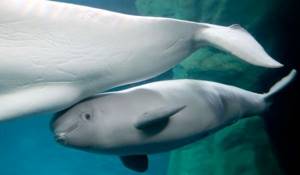
Photo: Beluga calf
Mating occurs between February and May. Males attract the attention of females by flirting, racing, playing and diving. At the same time, they make loud sounds, clicking and whistling. In the fight for females, males demonstrate their strength and superiority to their rivals. Males use tail slaps in the water, head shaking, sharp intimidating sounds and body language. They cut off the opponent with a sharp tilt of the body, block the road and demonstrate in every possible way that the territory is closed.
The decision to mate is made by the female. The caress of white whales is a beautiful sight. The couple plays, swims synchronously and touches their bodies. Offspring appear between March and September. Pregnancy lasts 400-420 days. Zoologists are confident that female white whales are capable of slowing down the gestation and birth of their calves. This assumption is made on the basis that births in the group occur almost at the same time. Since the process of conception is difficult to synchronize, the theory of fetal growth inhibition has arisen.
Newborn white whale calves weigh about 80 kilograms. The color of the babies is blue or gray. Calves stay with their mother for at least two years. All this time they are fed with milk. Lactation in a whale lasts from 1.5 to 2 years. Newborn babies are between two females: a mother and a teenage nanny. The cub is looked after, protected and lifted for a breath of air.
Whales reach sexual maturity at 4-7 years. Their maximum lifespan is 50 years. It is believed that females live on average up to 32 years, males up to 40.
Reproduction and lifespan

0
Beluga whales mate and give birth in coastal areas. It chooses places with warmer water. These, as a rule, are areas located near river mouths. Here, in the spring-autumn period, offspring are born. The cub is born alone and reaches a length of 1.4-1.6 meters. His weight reaches 70 kg. His mother feeds him with milk for a year and a half. She mates again two weeks after giving birth. Males mature at 7-9 years. Beluga whales stop growing at the age of 10-11 years. These mammals live 35-40 years.
Natural enemies of beluga whales
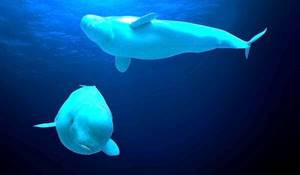
Photo: Beluga whales at sea
In nature, the beluga whale has a lot of enemies. As a rule, these are larger predators both underwater and on the shore. The nature of the predator, size and number depend on the beluga whale’s habitat. These include killer whales, polar bears, and Greenland sharks.
Beluga whales are very easy prey for polar bears. A white whale comes close to icebergs where hunting bears are located. Sometimes bears come to migrating ice specifically to hunt, and sometimes they stay on it for several days. Polar bears stalk beluga whales and attack using their claws and teeth.
Interesting fact: The beluga whale has several options for protection - camouflage, the ability to hide in the ice and behind a larger fellow tribesman who is able to repel a predator's attack.
Killer whales have a different way of hunting. As a pod of white whales begins their migration, the killer whale joins the group and accompanies it most of the way, constantly attacking and feeding. Beluga whales can usually hear killer whales, making it difficult to attack them. Due to the low maneuverability of killer whales in the ice, beluga whales manage to evade their pursuers.
Greenland sharks chase a school and attack not only during migration, but also in their habitats. However, white whales are capable of collective resistance. Animals often find themselves captured by Arctic ice and die, becoming prey to polar bears, killer whales and the local population.
People remain the most important danger and threat to the survival of the species. Hunting on an industrial scale for whale skin and blubber has significantly reduced the animal's population. The main dangers for these whales are toxic and industrial waste, garbage, as well as climate and environmental change in their breeding and habitat areas.
Scientists note that beluga whales are affected by noise pollution. The sharp growth and development of shipping, the increase in the flow of wild tourists interferes with normal reproduction and leads to a decrease in the number of calves, and as a result, a reduction in the herd.
Reproduction: feminist beluga whales?
The beluga dolphin is considered the most “prolific” among its relatives. After all, a female usually gives birth to two babies, while all other cetaceans usually give birth to only one.
It is interesting that after the female is fertilized, the male leaves her. At this time, females unite into separate flocks based on gender to bear their offspring. Scientists who have observed the behavior of these animals in the wild note that the mother beluga whale is distinguished by great care and love in nursing her cubs.
Population and species status
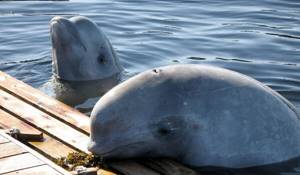
Photo: Beluga animal
Estimates of beluga whale abundance vary widely. The difference in numbers is tens of thousands. This is a fairly large error for such a small species.
The current worldwide population is between 150,000 and 180,000 animals. 30 habitat areas of the toothed whale have been noted - 12 are located on the territory of the Russian Federation. The largest group of whales - more than 46% - is constantly located off the coast of Russia.
Habitats of the main population:
- Bristol Bay;
- Eastern Bering Sea;
- Chukchi Sea;
- Beaufort Sea;
- Severnaya Zemlya;
- West Greenland;
- Western, Southern and Eastern Hudson Bay;
- St. Lawrence River;
- Spitsbergen;
- Franz Josef Land;
- Ob Bay;
- Yenisei Bay;
- Onega Bay;
- Dvinskaya Bay;
- Laptev sea;
- Western Chukchi Sea;
- East-Siberian Sea;
- Anadyr Bay;
- Shelikhov Bay;
- Sakhalin - Amur River;
- Shantar Islands.
Canadian ichthyologists count between 70,000 and 90,000 beluga whales in their region. The western Hudson Bay population is considered the largest in Canadian waters, with approximately 24,000 individuals. Beluga whales living in this part of the bay are considered resistant to external factors, despite the aggressive environment and human interference in the life of the toothed whale.
Migrating populations are counted simultaneously by representatives of different countries - Denmark, Norway, Russia, Canada and Great Britain. Their number at the starting point is very different from the finishing point. The numbers reflect group losses from predation and human activity.
A fairly large group of animals lives in zoos, oceanariums, national aquariums and dolphinariums. Scientists are at a loss as to how many individuals may be in captivity. According to some estimates, this could be 100 or more animals in Russia alone, and about 250 individuals in other countries of the world.











